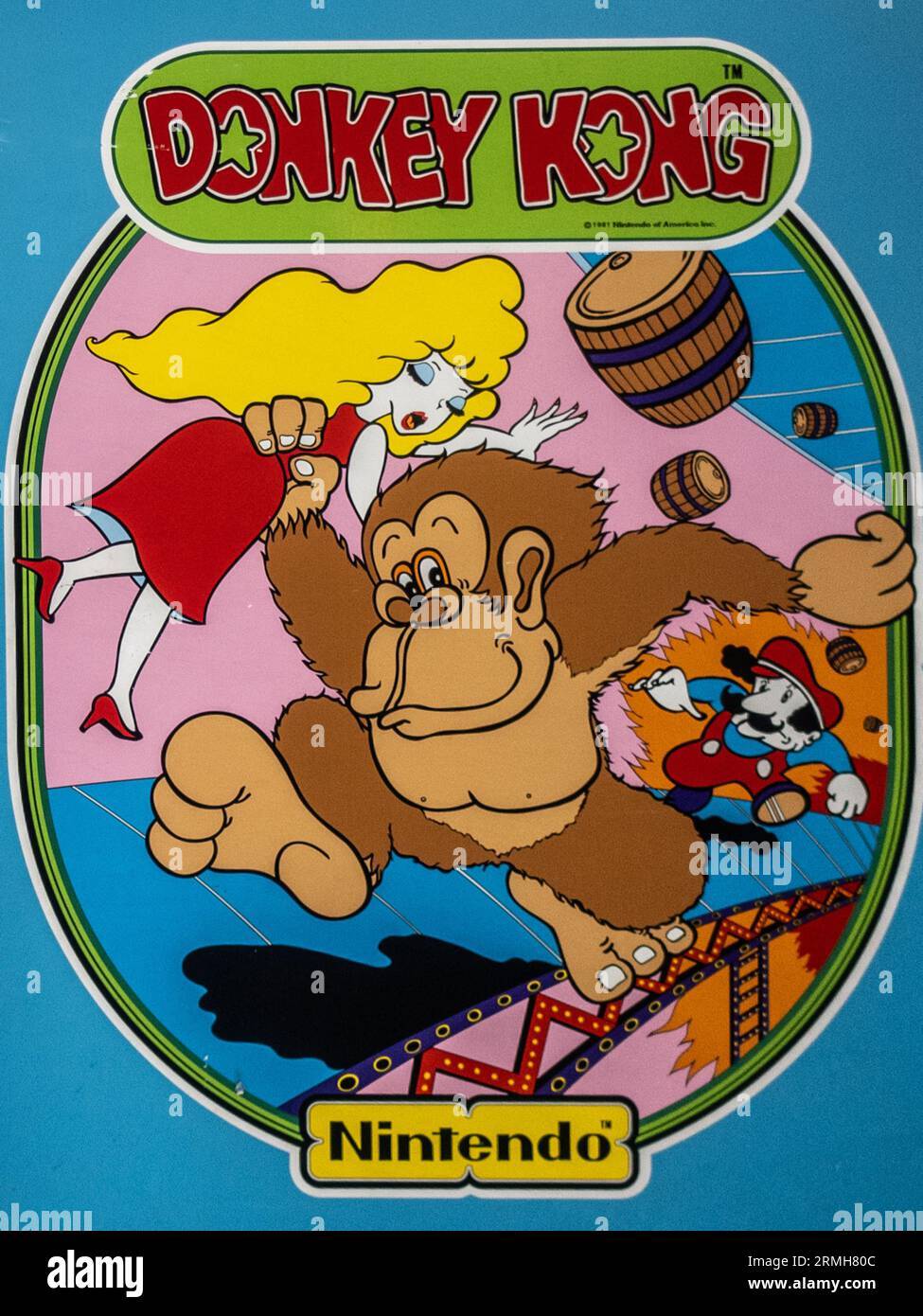
Picture this: it's 1981, and you're at an arcade, coins in hand. A massive ape hurls barrels down ramp...
Related Blogs
Why Donkey Kong Remains A Timeless Classic For Gamers Today
13 minutes, 46 seconds
-45 Views 0 Comments 0 Likes 0 Reviews

Donkey Kong: The Iconic Video Game Franchise That Shaped Gaming History
Picture this: it's 1981, and you're at an arcade, coins in hand. A massive ape hurls barrels down ramps while you, as a plucky hero, leap ladders to save the day. That game? Donkey Kong. It hooked players right away with its simple yet tough challenges. From those early days, it grew into a huge Nintendo staple. Think barrel blasts, banana chases, and wild adventures that still pull in fans old and new.
Over the years, Donkey Kong turned from a quick arcade hit into a full series across consoles. Key moments, like the big 1994 comeback on SNES, kept it alive. This article digs into the history of Donkey Kong, its gameplay tricks, and why it matters today. If you're searching for Donkey Kong games or its origin story, stick around. You'll get tips to play better and see how it changed video games forever.
The Origins of Donkey Kong
Donkey Kong started as a fresh idea in the late 1970s. Nintendo needed a win after some flops. Shigeru Miyamoto stepped up to craft something fun and new. The game blended platform jumps with puzzle elements. It drew from old cartoons but felt modern for arcades.
This origin story shows how one idea sparked a whole world. Early fans loved the mix of action and brains. Today, it ranks as a top classic in gaming history.
Shigeru Miyamoto's Vision and Creation
Shigeru Miyamoto dreamed up Donkey Kong from everyday spots. He walked trails in Japan and saw caves and cliffs. Those shaped the levels with ramps and drops. Nintendo wanted a Popeye game, but the deal fell through. So Miyamoto made his own characters: a big ape and a small carpenter.
The name "Donkey Kong" came from a funny mix-up. "Donkey" meant stubborn, and "Kong" nodded to King Kong. They picked it fast without deep thought. The barrel-throwing idea fit the ape's wild side. It let players dodge and climb in tight spaces. Hardware limits pushed smart designs, like reusing screens for levels.
Miyamoto's touch made it stand out. He aimed for joy in every jump. That vision built a base for all Donkey Kong games to come.
The 1981 Arcade Debut and Instant Success
Donkey Kong hit arcades in Japan first, then the US. It launched in July 1981 and spread quick. Players lined up for its fresh look. Nintendo sold over 60,000 cabinets by 1982. That cash pulled the company from debt after bad radar bets.
The hero was Jumpman, a mustached guy saving Lady from the ape. Barrels rolled down, and fireballs chased you. It set the damsel-in-distress style in games. Scores climbed as folks mastered the pie factory stage. Arcades buzzed with try after try.
This debut saved Nintendo and kicked off a boom. It proved simple games could rule. Fans still chase high scores from that era.
Legal Battles and Name Changes
Universal Studios sued Nintendo in 1982. They claimed Donkey Kong ripped off King Kong. Courts saw it as parody, not copy. Nintendo won big, proving their IP rights. The case set rules for game makers on fair use.
Jumpman became Mario after the win. It honored Nintendo's landlord, Mario Segale. That shift tied Donkey Kong to the plumber's rise. No more lawsuits meant focus on fun.
These fights shaped gaming laws. They let creators build bold worlds. Donkey Kong's story now includes this tough win.
Evolution of the Donkey Kong Series
The series grew from arcade roots to home play. Early ports hit the Atari 2600 and ColecoVision. Each step added layers to the ape's tale. Fans followed Donkey Kong's shift from foe to hero.
Key games mark the timeline of Donkey Kong. From 2D jumps to 3D worlds, it adapted well. Platforms changed, but the heart stayed the same.
From Arcade to Home Consoles: Early Sequels
Donkey Kong Jr. came in 1982. You played the ape's son, saving Dad from cages. Vines and springs added new moves. It flipped the story, making Donkey the good guy.
Donkey Kong 3 hit in 1983. Stanley, a bug sprayer, fought pests and the ape. Shots from a hose cleared screens. Ports to NES brought these to living rooms.
These sequels built the universe. New faces like Jr. and Stanley expanded play. They kept arcade thrill on home setups.
Donkey Kong Jr.: Climb ropes, grab keys.
Donkey Kong 3: Aim sprays at bugs and vines.
NES ports: Easy saves and replays.
Home versions made it family fun. Sales soared as kids joined in.
The 3D Revival with Donkey Kong Country
Rare took over in 1994 for SNES. Donkey Kong Country stunned with fake 3D looks. Pre-rendered sprites made apes and jungles pop. It sold over 9 million copies worldwide.
Diddy Kong joined as co-star. They rode pals like Enguarde the swordfish. Mines and caves hid secrets. Music from David Wise added swing to jumps.
This game beat rivals in the 16-bit fight. It proved Donkey Kong could shine again. Sequels on SNES kept the hype.
Fans loved the shiny graphics. It felt like a movie in game form. That revival hooked a new crowd.
Modern Iterations on Nintendo Platforms
Donkey Kong 64 launched in 1999 on N64. Collectibles filled huge worlds. Bananas and blueprints unlocked doors. It mixed platforming with light adventures.
Donkey Kong Country Returns hit Wii in 2010. Back to 2D, it brought mine-cart rides. Tropical Freeze followed on Wii U in 2014, then Switch. Ice slides and boss fights amped the fun.
Spin-offs include barrel games on phones. Mario Kart races feature Donkey too. Super Smash Bros. lets him brawl.
These updates keep it fresh. Switch ports let you play anywhere. The timeline of Donkey Kong shows steady growth.
Gameplay Mechanics and Signature Elements
Donkey Kong games mix jumps, dodges, and smarts. Barrels roll, enemies chase. You learn patterns to win. Tips help beat tough spots.
Core tricks stay timeless. From old arcades to new consoles, they challenge you. Grab power-ups for edges.
Classic Platforming and Puzzle Challenges
In the first game, climb ladders while barrels tumble. Time your jumps over gaps. Fireballs bounce off walls—watch their paths.
Pie factory levels reward quick moves. Score big by grabbing letters like "K-O-N-G." Avoid cement blocks in later stages.
Practice timing helps. Jump just as barrels peak. Start on easy screens to build skill. These puzzles test patience.
Why do they hook you? The "just one more try" feel. Master them, and you own the game.
Collectibles, Power-Ups, and Multiplayer Modes
Bananas fuel scores in later titles. Hoard them for extras. Animal buddies like Rambi charge through foes.
In Country games, find K-O-N-G letters per level. Secret exits lead to bonus worlds. Aim for 101% by hunting all.
Co-op shines in Returns. One player as Donkey, other as Diddy. Tag in for special moves.
Power-ups: Invincibility from red balloons.
Collectibles: Golden hearts for lives.
Multiplayer: Race barrels or brawl.
These add replay value. Share wins with friends.
Innovations in Controls and Accessibility
Tropical Freeze uses Wii remote shakes for pounds. It feels like slamming the ground. Switch joy-cons add tilt jumps.
Mobile mini-games touch to blast. Easy taps suit quick plays. Assists slow barrels for newbies.
Try simplified modes first. Build up to hard ones. Controls evolve but keep the rush.
These tweaks welcome all. Play your way, no stress.
Cultural Impact and Legacy of Donkey Kong
Donkey Kong touched movies, toys, and more. It birthed stars like Mario. Speedrunners chase records today.
Its legacy lives in Nintendo's core. From crossovers to revivals, it endures. Why? Pure fun that sticks.
Influence on Mario and Nintendo's Empire
Donkey Kong gave us Mario. That first hero jumped to plumbing fame. Super Mario Bros. owes its roots here.
Nintendo built mascots around it. Crossovers like Mario vs. Donkey Kong in 2004 pit them head-on. Puzzle twists keep the rivalry alive.
This start shaped the company. Billions in sales trace back. Donkey's world blends with Mario's seamlessly.
It shows one game can launch giants. Play both series—you see the links.
Appearances in Media and Merchandise
Donkey Kong pops in Wreck-It Ralph as a racer. Pixels film nods to arcades. Animated shorts on YouTube swing with tunes.
Merch includes Funko Pops of Diddy and Cranky. T-shirts show barrel art. Toys let kids build levels.
Google's 2011 Doodle let you play the original. Birthdays sparked global plays. Events like conventions feature cabinets.
These spots spread the love. Spot Donkey in stores or screens. It feels part of life.
Enduring Appeal in Esports and Retro Gaming
Speedrunners hit Twin Galaxies for records. Beat the game in under two hours? Top pros do it. Watch streams for tricks.
Nintendo Switch Online revives classics. Play with online friends. Legal emulators mimic arcades at home.
Set up a cabinet with Raspberry Pi. Use real joysticks for feel. Join communities for tips.
Retro fans thrive on this. Newbies find joy too. The appeal never fades.
Conclusion
Donkey Kong went from 1981 arcade star to franchise king. It saved Nintendo and sparked Mario's path. Key games like Country brought 3D flair and millions of sales.
Platforming shines with barrels and buddies. Tips like timing jumps or hunting secrets boost your play. Its legacy hits culture wide, from films to runs.
Dive into ports on Switch or phones. Replay for old vibes or find new levels. Check Nintendo's full lineup—Donkey waits. What game will you try first?
Photos

